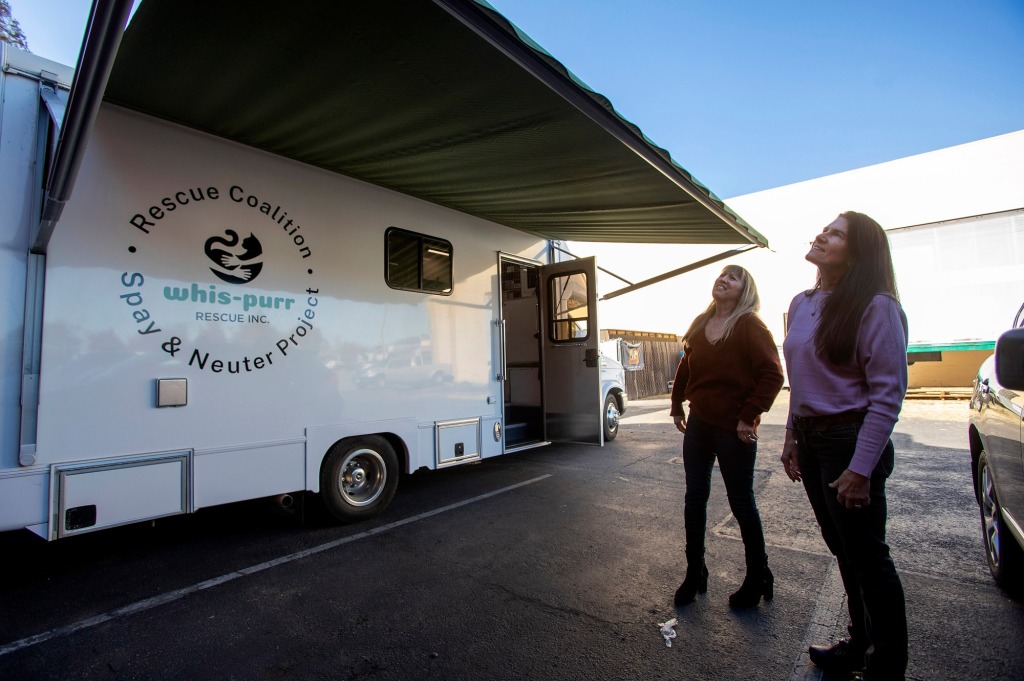Early in 2020, when COVID first came creeping in, shuttering businesses, sending thousands to the hospital and leaving others to shelter behind closed doors, an epidemic of a very different sort was quietly taking root.
In backyards, parks and alleyways, stray and feral cats were reproducing with little to hold them in check. Veterinarians had followed mandates to close their offices, or they were operating with limited staff, and public shelters reduced their intake or changed rules on how they handled stray and feral cats. And the stray cat population, estimated nationally at more than 70 million, continued to grow.
Even now, with restrictions eased, there is a backlog of kittens awaiting spay or neuter surgeries that will prevent them from reproducing and allow them to be adopted out.
It frustrated retired veterinarian Monica Rudiger no end. Although illness had forced her into early retirement, leaving a foundation she had started, Nine Lives, she wanted to do something about the growing cat population. Working with Whis-Purr cat rescue in Redwood City, she may have found a solution.
Non-profit rescue organizations are an important link in the chain that gets adoptable cats from public shelters straight into homes. Volunteers with the nonprofits scour shelters all over the state, looking for tame kittens and cats they can pull and place in a home. Most of these nonprofits are volunteer run and operate on shoestring business budgets, so they don’t have their own medical teams — they have to look for discounted surgeries.
Although the nonprofits will pull adult cats, the general public is more interested in adopting young kittens, and state law requires pets be neutered before they can be adopted out. Thus, it becomes critical that kittens are neutered as quickly as possible. With pandemic staffing issues clogging up the works, kittens are getting older as they wait for surgeries, and nonprofit organizations are filling up with cats they can’t yet adopt out.
Earlier this year, Rudiger thought of a way to unclog that bottleneck by getting a surgical van, one outfitted for doing spay and neuter procedures in the field, to give veterinarians a safe place to perform surgery and rescues a place to bring their cats.
Q. So how did you come up with the idea of a surgical van?
A. All the frustrations I was feeling, and the rescue groups were feeling, inspired me to come up with the spay van. The reaction to the whole lockdown seemed unnecessary. Vets could have continued working, but instead, we made it harder for the rescues to get any surgeries.
Q. How will having this van help?
A. What we’re trying to do is give the rescue groups that go to shelters and pull kittens turned in by the public a way to have the surgeries. Those rescue groups have suffered this year not being able to get surgery appointments.
Right now, groups have kittens in foster care for seven to eight months because they can’t adopt them until they have the surgery — and most people want to adopt kittens. It’s not right — 8-month-old cats are still cute — but the sooner we can get them adopted, the easier it is. And this will clear out the foster homes so they can take in more kittens.
Our plan is to work with the rescue groups and try the very best to get through as many cats per month as we can. If a rescue group has 24 cats sitting in foster care, we’d do those and then move on to another group.
Q. How many kittens will you be able to treat?
A. We can easily do 40 to 55 kittens in a day. It really doesn’t take that long. Surgery on small kittens is very, very fast — 4 to 6 minutes for girls; little boys take about a minute.
We’ll be working in partnership with the rescue groups. We are going to teach them recovery and aftercare and really get them involved. We really want everyone to work together and make it as successful as we can.
Q. Who will be doing the surgeries and how much will they cost?
A. We’re lining up vets who will perform the surgeries on their off days, maybe once or twice a month. Rescue groups will be paying for the surgeries, and the vets and technicians will be paid for their time. In time, it will become self-sustaining.
We’re only going to allow rescue groups to use the van, and we’ll do the surgeries eight or 10 days a month. It will depend on when vets are available, but it’s the best use of the time. Six to seven hours, and they’re done with it, and it will have such impact on the community. Cost will probably be $30 to $35 a cat.
I’m hoping if this project goes as planned, it will take the kittens off the (shelters’) surgery schedule, and the shelters can spay more feral cats from the trappers. Rescue groups are all scrambling for the same appointments, all beating each other down to get the appointments. It shouldn’t be that way.
Q. Will the van travel around the bay?
A. Right now, we want to keep overhead low, so the van will remain parked at Whis-Purr here in Redwood City. To have a driver and run a generator would be costly and a waste of time. Rescue groups will come to us.
The focus should always be on the cats, getting them neutered and adopted. This also is a way to get all rescues to work together, which isn’t something they’ve been doing. They shouldn’t have to be competing with each other for surgeries. They all have the same goal, which is to get cats and kittens adopted and keep the train going.
I’ve never seen the cat population so out of control. The pandemic didn’t care if the cats kept breeding, and they did. The pandemic set everyone back.
Q. How were you able to get the van?
A. We asked for donations and set a deadline of 90 days. It was a hard concept to explain, but people got it and wanted to be part of it. We were able to find a used surgical van, which just never happens, from SNIP in Monterey County. We still need to finish buying equipment, and we’ll be asking people for regular donations to get us going. I’m sure there will be more requests for surgeries than we can handle at first.
Q. When do you think you’ll be up and running?
A. We’re hoping to start in January. And I really hope other groups will see this and want to start their own. Then there could be vans all over the Bay Area. That would make such a difference.
Dr. Monica Rudiger
Organization: Whis-Purr Rescue Inc.
Position: Volunteer medical director
Age: 56
Birthplace: Palo Alto
Residence: Saratoga
Education: Undergraduate degree from UC Berkeley; doctor of veterinary medicine degree from Washington State
Five Things About Monica Rudiger
- She was 30 when she entered veterinary school.
- After her undergrad degree, she got married, had a baby and took more science classes before pursuing her veterinary dreams.
- She retired early after contracting a rare zoonotic disease, neurobartonellosis, a form of cat scratch disease that primarily affects the central nervous system.
- As much as she would love being a practicing vet again, physically she can’t.
- She always roots for the underdog, especially when it’s a cat.










